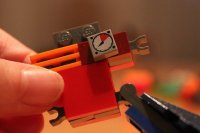“How Do I Teach This?” vs. “What Did We Learn?”
Your content has been saved!
Go to My Saved Content.In light of last week's release of the Next Generation Science Standards1 (NGSS), I'm reminded of a quote from a veteran teacher in my building:
"Do they really think the reason kids aren't proficient is because we don't know what to teach?"
As the media coverage and administrative spotlight is turned on these new benchmarks, I'd like us all to keep the following in mind: Engagement trumps all.
Student-Led Curriculum?
We're writing standards in an attempt to raise the bar -- well-intentioned, to be sure -- but in the end, students and teachers can only jump as high as their curiosity will let them. For all their digital elegance, the NGSS divert attention away from the much larger issue: we have millions of children in schools learning things on narrative arcs that they had no part in authoring.
You might argue that those narrative arcs are similar enough year-to-year to be plannable, but you have to remember: it's new to the students.
What’s more, writing better documents, atomizing curriculum, and reorganizing the time when students learn about stars will do little to address the need for engagement with why they're interested in stars (if at all, yet).
This is why the project-based learning (PBL)2 approach is so popular. A good project brings the students in and gives motivation to all of the content that, at the end of the project, we'll hang on the experiences they've gained.
Another way to put it is that we should never ask the question, "How am I going to teach standards PS.SS1.1.E?" We should instead ask, once our students have paused at the end of a lesson or unit, "What do you think you learned?"
For example, we should be asking students to go through the NGSS, after building a sweet LEGO robot, and circle the standards they think they learned about. The teacher can then clean up the formalization of those standards with direct instruction after comparing their circles to the students'.
The Glove
This happened in my classroom recently when a project spiraled so far out from under my auspice and into the students' control that I was surprised each day when I came back to check on its progress.
I had introduced them to the Arduino3 microcontroller and associated programming language. I had the hunch that I would hit common physical science standards; things like Ohm's law, charge, capacitance and the vagaries of "technology."
The students quickly devoured the simple, blinking-LED example, and things got really awesome. It turned into a quick frenzy of prototyping ideas, followed by some explaining, followed by them shushing me so they could figure more out.
This all led to the construction of an homage to the Nintendo Power Glove.4 No single person, including myself, can be credited with the idea and final design.
Our prototype running on Arduino UNO and graphics in Processing
We're now delving into programming, vectors and matrices; it's funny how learning isn't atomized until way after it's finished.
Paying Attention to Design
The students spent some serious time with a Stanford design school protocol.5 They developed several ideas for single- and multi-player games. We reworked the ideas, distilled out the most fun and engaging elements from each, and continued until we had developed a game suited to our power gloves: a co-op game where two people control one virtual bird, flapping its wings with their fingers to avoid trees and collect berries.
I'm not sure any of this would have happened if I had started with the standards. I do know that my students listed things they had learned well beyond anything in the NGSS.
STEM to STEAM to STEHALM
You know what they say about semicolons; ever notice how this list just keeps getting longer? Probably because the separations between the content areas is fictional at best, and actively damaging to students at their worst.
I interact with a lot of students who love the idea that once they leave a class or a semester ends, they never have to think about it again. Maybe that's a little heavy-handed, but if we're looking to increase our output of STEM thinkers and doers, we're going to need students to embrace the idea that everything is connected, and they shouldn't flee from new content just because it's not what they're expert in.
That previous paragraph has been written ad nauseum in education circles, and I'd like to expound on one point: you can't, through perfect planning, make a good STEM lesson. Your only bet is to pick a system that's interesting and help the students run with it.
As more and more references to STEAM (Science, Tech, Engineering, Arts and Math) flood my Twitter feed, I can't help but wonder how long until we all realize that lessons go where they will, which results in unplannable but reflectable STEHALM (Science, Tech, Engineering, History, Arts, Language and Math) experiences.
So, what systems have you let your students play with that resulted in richer learning than they'd get in a more traditionally planned lesson? Please share your experiences in the comments section below.
Sources
1http://www.nextgenscience.org/next-generation-science-standards
2http://www.edutopia.org/blogs/beat/project-based-learning?gclid=CO3QjtDuz7YCFXSVMgod9zoApA
3http://www.arduino.cc/
4http://www.youtube.com/watch?v=KZErvASwdlU&feature=player_embedded
5https://dschool.stanford.edu/groups/designresources/wiki/ed894/
